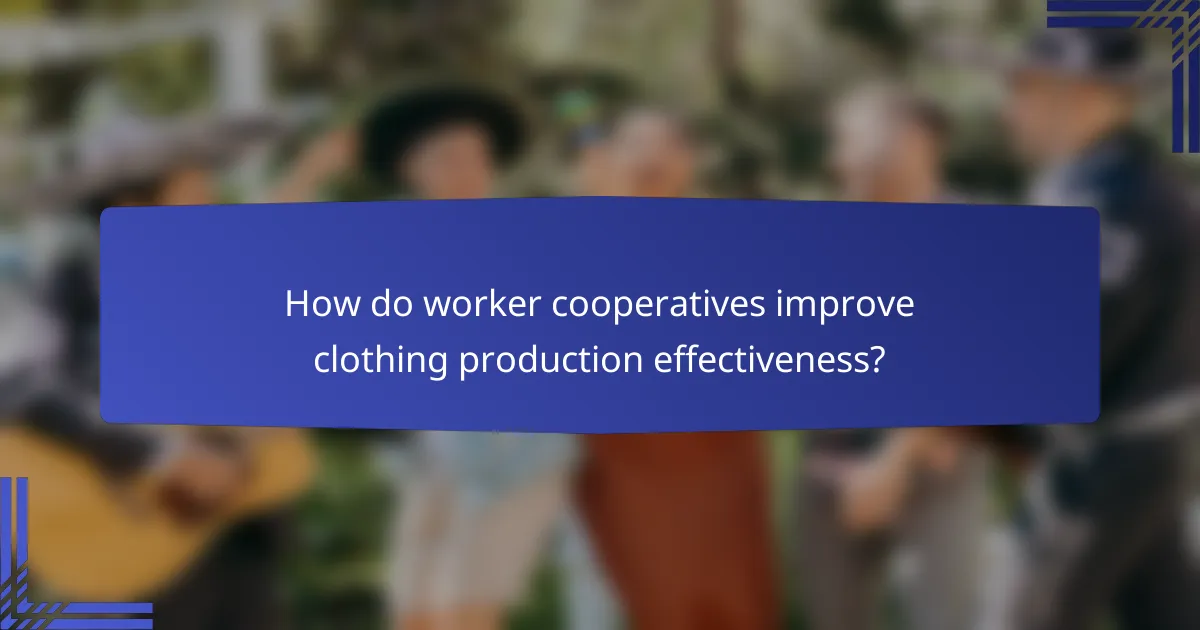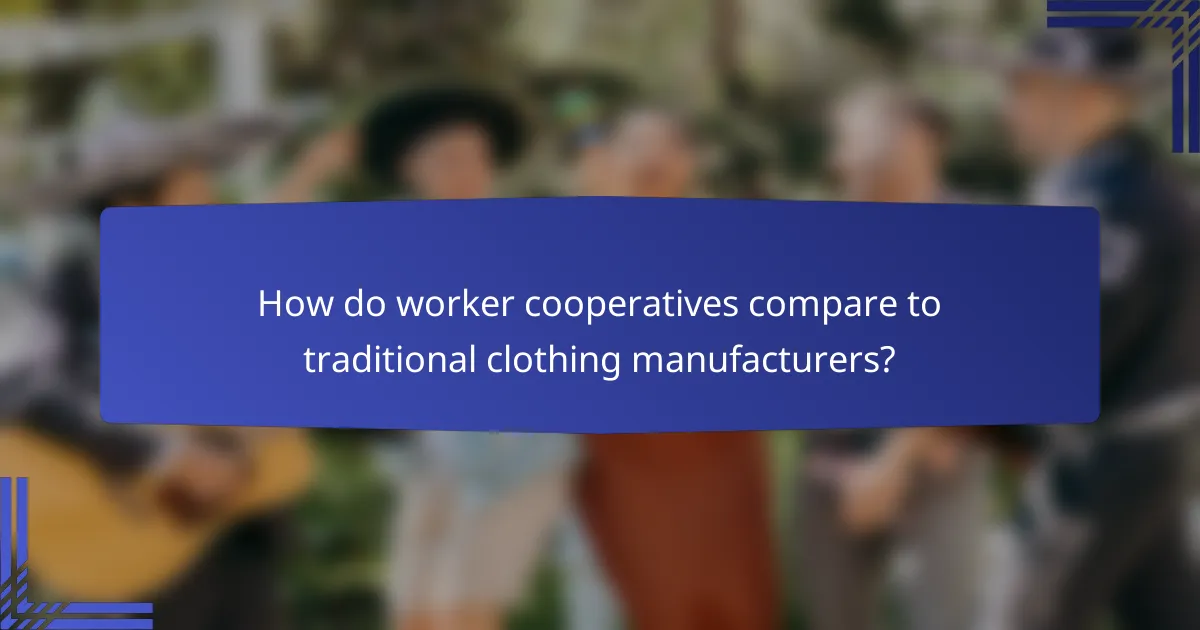Worker cooperatives are transforming clothing production by creating a collaborative environment where employees actively participate in decision-making and quality control. This model not only enhances engagement and product quality but also promotes equitable profit sharing and sustainable practices, resulting in a more ethical production system. By prioritizing workers’ rights and community involvement, these cooperatives often achieve greater cost efficiency and adaptability compared to traditional manufacturers.

How do worker cooperatives improve clothing production effectiveness?
Worker cooperatives enhance clothing production effectiveness by fostering a collaborative environment where employees are directly involved in decision-making and quality control. This structure leads to higher engagement, improved product quality, and more efficient operations.
Enhanced worker engagement
In worker cooperatives, employees have a stake in the success of the business, which significantly boosts their engagement levels. When workers feel valued and empowered, they are more likely to invest effort into their tasks, leading to increased productivity and morale.
For example, in a cooperative clothing factory, workers might participate in regular meetings to discuss production goals and challenges. This involvement not only motivates them but also encourages innovative solutions that can enhance overall effectiveness.
Increased quality control
Quality control in worker cooperatives is often more rigorous due to the collective responsibility shared among members. Each worker understands that their contributions directly impact the final product, which encourages them to maintain high standards throughout the production process.
Cooperatives can implement peer-review systems where workers assess each other’s work, fostering a culture of accountability. This approach can lead to fewer defects and higher customer satisfaction, ultimately benefiting the cooperative’s reputation and sales.
Streamlined decision-making
Decision-making in worker cooperatives tends to be more agile compared to traditional hierarchical structures. With fewer layers of management, decisions can be made quickly, allowing the cooperative to respond promptly to market changes or production issues.
For instance, if a particular fabric is not performing well, a cooperative can swiftly convene to discuss alternatives and implement changes without lengthy approval processes. This flexibility can lead to better alignment with consumer demands and improved operational efficiency.

What are the benefits of worker cooperatives in the clothing industry?
Worker cooperatives in the clothing industry offer several advantages, including equitable profit sharing, enhanced community engagement, and a commitment to sustainable practices. These benefits contribute to a more ethical and resilient production model that prioritizes workers’ rights and environmental stewardship.
Fair profit distribution
In worker cooperatives, profits are distributed among members based on their contribution rather than hierarchical positions. This model ensures that all workers have a stake in the success of the business, leading to higher motivation and job satisfaction.
Typically, profit-sharing can range from 50% to 80% of net earnings, depending on the cooperative’s structure and agreements. This equitable distribution fosters a sense of ownership and responsibility among workers, encouraging them to invest in the quality and efficiency of their production processes.
Community empowerment
Worker cooperatives empower local communities by creating jobs and supporting local economies. By prioritizing local hiring and sourcing materials from nearby suppliers, these cooperatives help to strengthen community ties and reduce reliance on global supply chains.
Moreover, cooperatives often engage in community initiatives, such as educational programs or local events, which further enhance their social impact. This focus on community can lead to a more loyal customer base, as consumers increasingly favor businesses that contribute positively to their surroundings.
Sustainable practices
Many worker cooperatives in the clothing sector prioritize sustainable practices, such as using organic materials and implementing eco-friendly production methods. This commitment not only benefits the environment but also appeals to a growing market of eco-conscious consumers.
For instance, cooperatives may adopt practices like zero-waste production or utilize renewable energy sources, which can significantly reduce their carbon footprint. By aligning their operations with sustainability goals, these cooperatives can differentiate themselves in a competitive market and attract customers who value ethical consumption.

How do worker cooperatives compare to traditional clothing manufacturers?
Worker cooperatives often outperform traditional clothing manufacturers in several key areas, including cost efficiency, employee satisfaction, and adaptability. These cooperatives empower workers by giving them a stake in the business, leading to unique operational advantages.
Lower overhead costs
Worker cooperatives typically have lower overhead costs compared to traditional clothing manufacturers. This is largely due to the absence of profit-driven executives and the shared responsibility among worker-owners, which can lead to more efficient resource allocation.
For example, cooperatives often utilize shared spaces and equipment, reducing the need for extensive capital investment. This can allow them to offer competitive pricing, which is crucial in the fast-paced clothing market.
Higher employee retention
Employee retention rates in worker cooperatives tend to be higher than in traditional clothing companies. This is because workers in cooperatives have a direct say in decision-making and benefit from profit-sharing, which fosters a sense of ownership and loyalty.
Research indicates that cooperatives can see retention rates exceeding 80%, compared to lower rates in conventional firms. This stability can lead to a more experienced workforce, ultimately enhancing productivity and quality in clothing production.
Flexibility in production
Worker cooperatives often exhibit greater flexibility in production processes than traditional manufacturers. This adaptability allows them to respond quickly to changing market demands and consumer preferences, which is essential in the clothing industry.
For instance, cooperatives can easily pivot to produce limited-run items or sustainable clothing lines without the bureaucratic hurdles typical of larger corporations. This responsiveness can be a significant advantage in capturing niche markets and trends.

What challenges do worker cooperatives face in clothing production?
Worker cooperatives in clothing production encounter several significant challenges that can hinder their effectiveness. These include difficulties in accessing funding, intense market competition, and obstacles in scaling their operations.
Access to funding
Accessing funding is a primary challenge for worker cooperatives, as traditional lenders may be hesitant to finance businesses without a conventional ownership structure. Many cooperatives rely on member contributions, which can limit available capital and slow growth.
To improve funding opportunities, cooperatives can explore grants specifically aimed at social enterprises or seek partnerships with organizations that support cooperative business models. Crowdfunding can also be an effective way to raise capital while engaging the community.
Market competition
Worker cooperatives often face stiff competition from larger, established clothing manufacturers that benefit from economies of scale. These larger companies can offer lower prices, making it difficult for cooperatives to attract price-sensitive customers.
To compete effectively, cooperatives should focus on niche markets, emphasizing quality, ethical production, and sustainability. Building a strong brand identity that resonates with consumers who value social responsibility can also help differentiate cooperatives from their competitors.
Scaling operations
Scaling operations presents a unique challenge for worker cooperatives, as growth often requires balancing member involvement with operational efficiency. Expanding production capabilities can strain resources and complicate decision-making processes.
Cooperatives should consider phased growth strategies, such as gradually increasing production capacity or diversifying product lines. Establishing clear roles and responsibilities among members can also streamline operations and facilitate smoother scaling.

What are the prerequisites for starting a clothing worker cooperative?
Starting a clothing worker cooperative requires a clear understanding of legal structures, a strong commitment from members, and thorough market research. These prerequisites ensure that the cooperative can operate effectively and sustainably in the competitive clothing industry.
Legal structure understanding
Understanding the legal structure is crucial for forming a clothing worker cooperative. This includes deciding whether to register as a cooperative, LLC, or another entity type, which affects liability, taxation, and governance. Each structure has different requirements and implications, so consulting with a legal expert is advisable.
In many countries, cooperatives must adhere to specific regulations that govern their formation and operation. Familiarizing yourself with local laws, such as those pertaining to member rights and financial reporting, can prevent future legal complications.
Member commitment
Member commitment is essential for the success of a clothing worker cooperative. Each member should be dedicated to the cooperative’s mission and willing to invest time and resources. This commitment often translates into shared responsibilities, such as production, marketing, and financial management.
To foster commitment, consider implementing a clear onboarding process that outlines roles, expectations, and benefits. Regular meetings and open communication can also help maintain enthusiasm and accountability among members.
Market research
Conducting thorough market research is vital for understanding the clothing industry’s dynamics. This includes analyzing competitors, identifying target customers, and assessing trends in sustainable fashion. Gathering this information helps in making informed decisions about product offerings and pricing strategies.
Utilize surveys, focus groups, and industry reports to gather insights. Additionally, consider testing prototypes or small batches to gauge customer interest before fully launching your product line. This approach minimizes risk and aligns offerings with market demand.

How can consumers support worker cooperatives in clothing production?
Consumers can support worker cooperatives in clothing production by choosing to buy from these organizations and advocating for fair labor practices. This not only helps sustain cooperative businesses but also promotes ethical production methods that benefit workers directly.
Purchasing from cooperatives
Buying clothing from worker cooperatives ensures that profits are distributed among the workers rather than external shareholders. This model often leads to better working conditions and fair wages, as the workers have a direct stake in the success of the business.
When purchasing from cooperatives, look for labels or certifications that indicate the clothing is made by a cooperative. Many cooperatives have websites or social media pages where they showcase their products and share their stories, making it easier for consumers to connect with them.
Consider shopping at local markets or online platforms that specialize in cooperative goods. By prioritizing these purchases, consumers can help create a sustainable demand for ethically produced clothing, fostering a more equitable fashion industry.
